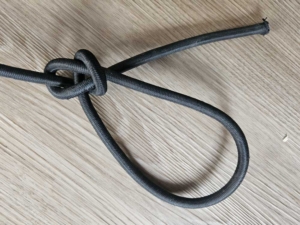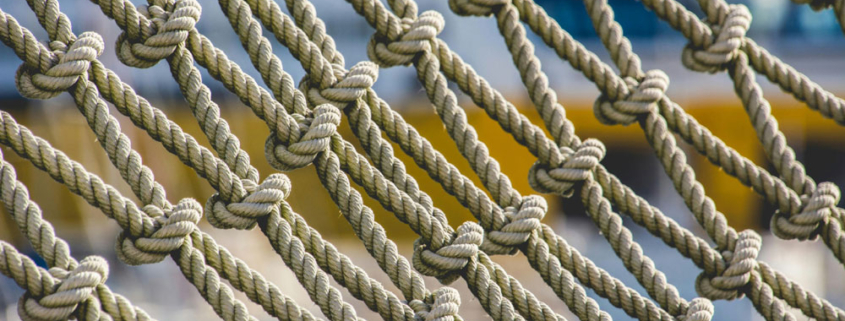Knot Tying: 6 Essential Knots
These 6 examples of knot tying are an important skill for outdoor enthusiasts, boaters, climbers, and anyone engaging in activities that involve ropes. Each knot serves a specific purpose. In this guide, we’ll explore the applications of only six knot types to get you started. Know there are dozens of knot types that serve varying purposes.
Disclaimer: Climbing is inherently risky, and knot tying is a skill in managing those risks. The information provided here is for educational purposes only. Before engaging in any rope activity, ensure that you receive proper training and guidance from certified professionals. Practice tying knots in controlled environments. Always prioritize safety, seek qualified instruction, and exercise caution.
-
Square Knot:

square knot
The square knot, also known as the reef knot, is a simple knot used for joining two ropes of similar diameter. Its primary applications include:
- Securing Packages: When packaging items or securing a bundle, the square knot provides a quick and straightforward way to join two ends of a rope securely.
- Tying Bandages: Used to tie bandages or fabric strips together, providing a snug and adjustable fit.
- Crafts and Hobbies: Artists and crafters use square knots to create friendship bracelets, keychains, and various decorative items.
-
Bowline Knot:

Bowline knot
The bowline knot forms a secure and non stick loop at the end of a rope and is known for its reliability. Key applications include:
- Rock Climbing: Climbers often use the bowline to secure themselves to a harness, creating a reliable and easily untied loop.
- Rescue Situations: In rescue scenarios, the bowline creates a loop to hoist or lower people or equipment safely.
- Sailing: Sailors secure sails to lines, creating a non-slip loop easily untied, even after being subjected to heavy loads.
- Camping: Used for securing tents or tarps.
-
Figure 8 Knot:

Figure 8 knot
The figure 8 knot, also known as the Flemish knot, is used as a stopper knot at the end of a rope. You can follow the 8 around to make a double figure 8 knot. See the video below by Billy as he demonstrates how to tie this variation!
Its applications include:
- Rock Climbing: Creates a secure and easily recognizable stopper at the end of a climbing rope.
- Boating: To prevent lines from slipping through cleats or blocks.
- Camping: Used as a stopper knot to prevent tent lines from slipping through stakes.
- Scouting and Girl Guides use this knot to tie their scarves & ties.
-
Alpine Butterfly Knot:

Alpine Butterfly Knot
This knot I had to enlist my 14 year old son to help me learn. It is very unique and once we figured it out, its really quite fun to tie! The alpine butterfly knot creates a secure mid-line loop, and is a good choice for load bearing needs. You can find applications in various outdoor activities:
- Climbing and Mountaineering: Climbers use the alpine butterfly to create a secure and load-bearing loop in the middle of a rope.
- Rescue Operations: Rescue teams use this knot to create a central attachment point for hoisting or lowering operations.
- Hikers and campers use the alpine butterfly to create a secure attachment point for hanging gear or creating a makeshift clothesline.
-
Double Half Hitch Knot:

Double Half Hitch Knot
The double half hitch knot is a simple hitch that adds stability to other knots or is used on its own. Applications include:
- Securing Tarps and Tents: Campers secure tent lines or attach tarps to trees or poles.
- Boating: When securing a boat to a docks.
- Creating Quick Lashings: Used to quickly lash together branches or other materials for shelter construction.
6. Slip Knot:

Slip Knot
- A quick release, easy to tie (and untie) knot
- Slip Knots create a temporary tourniquet or to secure a makeshift bandage.
- Artists and DIY enthusiasts use slip knots for various crafting projects or for quickly lashing together materials.
- Commonly used by ranchers and farmers when tying off horses or cows
- I use a slip knot to tie off excess rope or line, to keep it off the ground, and neat and tidy.
- Not ideal for heavy loads because it is not as secure as other knot styles.
Conclusion:
Mastering these fundamental knots provides a solid foundation for anyone working with ropes in various environments. Practice tying them in different scenarios to build confidence in your knot-tying skills. Happy tying!



